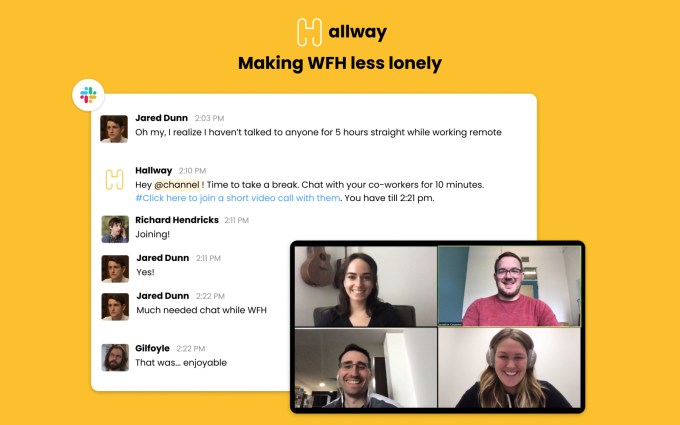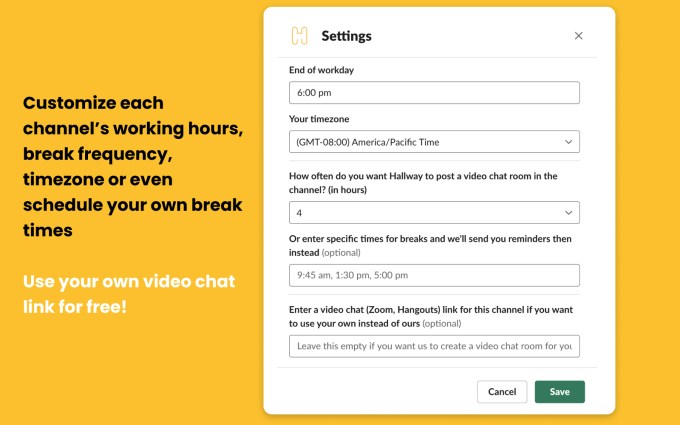Hallway creates a ‘virtual break room’ for remote workers using scheduled video chats [TechCrunch]

The coronavirus outbreak has forced millions of U.S. employees to work from home — many for the first time. But remote work can be lonely and isolating, as people feel disconnected from their team and co-workers due to the lack of face-to-face conversations. That’s where the new startup, Hallway, aims to help. The service re-creates the break-room experience and the serendipity of random hallway conversations with its new app aimed at Slack users.
The app allows companies to schedule 10-minute video chats within Slack channels, where colleagues can catch up with one another outside of more formal web meetings.
The startup was co-founded by Parthi Loganathan, a former product manager at Google who launched Google Chat and Google Go; and Kunal Jasty, a former associate at private equity firm Insight Partners.
The two were originally working on a product called Across that would help teams provide customer support in shared Slack channels. But when the shelter-in-place was brought into effect in San Francisco, things quickly changed.
“It forced a lot of companies that were unprepared for remote work to go remote overnight,” Loganathan explains. Meanwhile, his roommate complained he was going stir-crazy working from home and missed talking to his team.
“Hallway seemed like a simple and fun way to tackle that problem, so we built it in a couple of days,” Loganathan says.

The founders already had first-hand experience with the challenges involved in dealing with remote teams, as half their team was based in India. And they had experience building Slack apps, not only with Across but with others similar to Hallway, as well.
As a result, Hallway was built quickly, with only four days in between the idea and the first user, Loganathan says.
To use Hallway, you can either add it to Slack from the Hallway website or from the Slack app directory. (To install it, you may need admin approval if you don’t have permission to add apps to your Slack workspace.)
There’s no front-end for the app — everything is user-facing in Slack, including the login process, onboarding experience and the settings user interface. Once installed, you’re given the onboarding instructions over direct message within Slack. You can then invite the Hallway bot to any Slack channel by typing /invite @hallway. This kicks off the bot to start creating break rooms on a recurring basis automatically, which are announced by way of an @here message.
By default, Hallway’s break rooms are scheduled every two hours between 9 AM and 6 PM Monday through Friday, but users can adjust the timezone and adjust the frequency of the breaks by typing in /hallway in a Slack channel to customize the settings.
You can opt to use your own Zoom or Google Meet links with Hallway. But the experience works better with Hallway’s timed video chat rooms, which are powered by daily.co’s video infrastructure.

The service itself is free for up to two slack channels, but only offers 10 of its timed video chats before you have to either switch to using your own web meeting links or have to upgrade.
Hallway’s “team” pricing plan for larger companies supports up to five channels and offers an unlimited number of video chat rooms, as well as the customization options, for $30 per month. For more than five channels, enterprise pricing is available upon request.
Since launching just a few weeks ago, Hallway has quickly grown its customer base.
The service is now being used by more than 170 teams at companies like Nextdoor, Productboard, Bank Novo, Pivotal, Coursera and others. The majority of users are on the free plan for now. However, companies in need of an upgrade can access more flexible pricing if users are willing to share the service with friends.
For the time being, the co-founders want to focus on improving the Hallway experience in Slack, but they’re already thinking about what comes next.
“We’re solving the problem of keeping teams connected and reducing workplace loneliness while working remotely. Right now, we’re improving the core experience of spontaneous timed video chats and giving users more options to customize them,” says Loganathan. “We’re looking into specific use cases we can help companies with, like team building and employee onboarding for remote teams,” he notes.
The company may also consider a solution for Microsoft Teams in the future, he says.
Hallway has raised an undisclosed amount of pre-seed funding.
Source: TechCrunch https://techcrunch.com/2020/04/13/hallway-creates-a-virtual-break-room-for-remote-workers-using-scheduled-video-chats/


Post a Comment